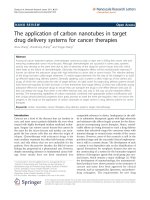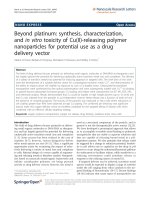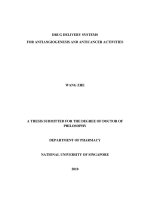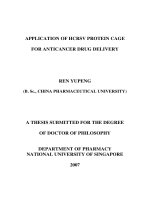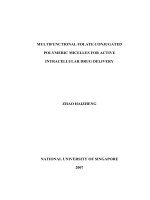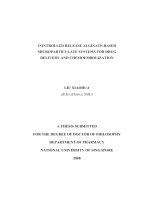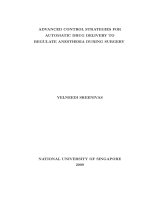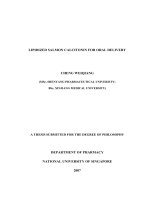Chitosan hybrid microgels for oral drug delivery
Bạn đang xem bản rút gọn của tài liệu. Xem và tải ngay bản đầy đủ của tài liệu tại đây (4.89 MB, 10 trang )
Carbohydrate Polymers 239 (2020) 116236
Contents lists available at ScienceDirect
Carbohydrate Polymers
journal homepage: www.elsevier.com/locate/carbpol
Chitosan hybrid microgels for oral drug delivery
a,
a
T
b
Michelly Cristina Galdioli Pellá *, Andressa Renatta Simão , Michele Karoline Lima-Tenório ,
Ernandes Tenório-Netob, Débora Botura Scariotc, Celso Vataru Nakamurac, Adley Forti Rubiraa,*
a
b
c
Department of Chemistry, State University of Maringa, Av. Colombo, 5790, CEP, 87020-900, Maringa, Parana, Brazil
Department of Chemistry, State University of Ponta Grossa, Av. Gen. Carlos Cavalcanti, 4748, CEP 84030-900, Ponta Grossa, Parana, Brazil
Department of Basic Science of Health, State University of Maringa, Av. Colombo, 5790, CEP 87020-900, Maringa, Parana, Brazil
A R T I C LE I N FO
A B S T R A C T
Keywords:
Chemical modification
SiO2 nanoparticles
Glycidyl methacrylate
In the present work, hybrid microgels based on chitosan and SiO2 nanoparticles (NPs) were synthesized. Both
chitosan and the SiO2 NPs were submitted to chemical modification reactions to having vinyl groups incorporated into their structures. The microgels were synthesized by emulsion polymerization. SEM analysis
indicated a high dispersity of diameter for the microgels, ranging between (18.7 ± 12.3) μm for the samples
without SiO2-VTS and (11.3 ± 8.07) μm for the microgels with SiO2-VTS. The material showed pH-responsiveness, especially in acidic pHs. The longest release lasted 45 min and large amounts of drugs were released as
soon as the material was added to the release medium. It is interesting for oral drug delivery systems, especially
for gastric wound treatment. The fast release of high amounts of drugs promotes an immediate relief of the pain
and the following controlled release allows the gradual recovery of the damaged area.
1. Introduction
The development of devices with efficient controlled release behavior is a big challenge regarding gastrointestinal disorders (Ensign,
Cone, & Hanes, 2012). Inorganic nanoparticles (Heneweer, Gendy, &
Peñate-Medina, 2012), hydrogels (Langer & Peppas, 2003; Soares et al.,
2016; Wang et al., 2013), microgels (Bysell, Månsson, Hansson, &
Malmsten, 2011; Sivakumaran, Maitland, & Hoare, 2011), and nanogels
(Wang et al., 2013) are examples of devices used as drug delivery
systems.
Hydrogels are tridimensional devices, chemical or physically
crosslinked (Ahmad, Rai, & Mahmood, 2016). This tridimensional
structure allows the allocation and transport of bioactive molecules,
like drugs (Ahmad et al., 2016). It minimizes or prevents the effect of
different physiological environments over the drugs (Langer & Peppas,
2003). Hydrogels can be used in a macro, micro or nanoscale (Ahmad
et al., 2016), being their size an important factor regarding the form in
which the hydrogel will be administrated. They can be orally administrated (Park, 1988), implanted (Cohn, Sosnik, & Garty, 2005) or injected in the body (Jeong, Bae, & Kim, 2000).
Among their properties, these tridimensional gels can respond to
several types of stimuli like pH, ionic strength, temperature, electromagnetic field (Grainger, 2013), etc. They also can swell water, expanding their chains, which allows the release of bioactive agents
⁎
entrapped in their structure. It makes hydrogels a minimally invasive
device (Grainger, 2013).
Synthetic and natural polymers are suitable for the obtention of
hydrogels and microgels (Ahmad et al., 2016). However, when it comes
to biological applications, natural polymers become more interesting
because they are biocompatible, biodegradable, and non-toxic (Simão
et al., 2020).
Chitosan (CTS) is a polysaccharide widely used in the synthesis of
hydrogels and microgels (Kang & Kim, 2010; Zhou et al., 2016). Due to
the presence of amino-groups (-NH2) in its structure, chitosan is a positively charged polymer whose chains can be easily modified (Zeng,
Fang, & Xu, 2004). This polymer is biocompatible, biodegradable, nontoxic (Zeng et al., 2004), and also shows antimicrobial activity (Xu
et al., 2012). Furthermore, chitosan-based devices have been used for
the delivery of drugs destined for the treatment of gastrointestinal
disorders (Hejazi & Amiji, 2003).
In the past years, drug delivery devices have been improved by the
combination of polymeric devices (like microgels) and inorganic nanoparticles (Grainger, 2013; Lu, Zahedi, Forman, & Allen, 2014). These
inorganic nanoparticles can be biocompatible, non-toxic, and bioabsorpt (Soares et al., 2016). They have been being combined with
polymeric materials like, for example, aiming to improve the drug delivery system (Lu et al., 2014).
One example of inorganic nanoparticle with attractive properties is
Corresponding authors.
E-mail addresses: (M.C. Galdioli Pellá), (A.F. Rubira).
/>Received 19 March 2020; Received in revised form 25 March 2020; Accepted 27 March 2020
Available online 09 April 2020
0144-8617/ © 2020 Elsevier Ltd. All rights reserved.
Carbohydrate Polymers 239 (2020) 116236
M.C. Galdioli Pellá, et al.
SiO2. Non-porous SiO2 nanoparticles have been used as reinforcements
for polymeric materials (Molatlhegi & Alagha, 2017) while porous SiO2
nanoparticles can be used for the allocation and release of drugs (Wu &
Sailor, 2009). In the present work, non-porous SiO2 nanoparticles were
used as reinforcements for the microgels and to increase the space between the chains.
Considering the several advantages of drug delivery systems, the
present work aimed to develop efficient hybrid microgels based on
chemically modified chitosan, reinforced with modified SiO2 nanoparticles, capable of completely releasing drugs in short periods. It also
aimed to evaluate if the microgels were pH-responsive as well as their
potential application on the treatment of gastric disorders.
Table 1
Factorial design for the evaluation of GMACTS (%) and SiO2-VTS (%) effect over
microgels properties.
Sample
GMA
SiO2-VTS (%)
MG-C1A30T4
MG-C1A30T4S
MG-C2A30T4
MG-C2A30T4S
MG-C2.78A30T4
MG-C2.78A30T4S
1
1
2
2
2.78
2.78
0
1
0
1
0
1
CTS (%)
assays, the amount of vitamin-B12 utilized was correspondent to 10%
of the GMACTS amount.
Table 1 shows the factorial design performed to evaluate the effect
of SiO2-VTS over the properties of the microgels. The factors were the
amount of GMACTS and SiO2-VTS.
The samples were named “MG-CxA30T3”, where MG means microgel, the upper letters C, A, and T means GMACTS, amplitude
(equivalent to 30%) and time (equivalent to 3 min of sonication), respectively, and the sub-index ‘x’ refers to the amount, in percentage, of
GMA
CTS utilized. Samples containing SiO2-VTS NPs also have the letter
S in the name.
2. Materials and methods
2.1. Materials
Mowiol poly(vinyl alcohol)® (PVA; 86.7–88.7 mol % hydrolysis, Mw
∼31.000 Da), Glycidyl methacrylate (GMA), poly(vinyl pyrrolidine
K10) (PVP), chitosan (CTS; 75–85 % deacetylated, Mw
50.000–190.000 Da), tetraethylorthosilicate (TEOS), and vitamin B12
were obtained from Sigma-Aldrich. Hydroquinone was obtained by
Synth. Vinyltrimethoxysilane (VTS) was obtained from Acros. Dulbecco
modified eagle medium (DMEM) and bovine fetal serum were obtained
from Gibco®, and (3-(4,5-dimethyltiazol-2-il)-2-5-diphenyltetrazolium)
bromide (MTT) was obtained from Amresco®. All the other reactants
were at an analytical degree.
2.3. Characterizations
2.3.1. Fourier transform infrared (FTIR)-attenuated total reflection (ATR)
The materials were characterized by FTIR-ATR (from 4000 to
400 cm−1, Perkin Elmer Equipment) to confirm the occurrence of the
chemical modifications.
2.2. Methods
2.2.1. Chitosan chemical modification with GMA
Chitosan was modified with GMA according to the method reported
by Garcia-Valdez, Champagne-Hartley, Saldivar-Guerra, Champagne,
and Cunningham (2015). In brief, 1 g of chitosan was solubilized in
100 mL of acetic acid 0.4 M previous to the addition of GMA, KOH, and
hydroquinone. The solution was degasified for 30 min, and then, the
temperature was increased to 70 °C. The system was kept under magnetic stirring and reflux for 2 h.
At the end of the reaction, the solution (GMACTS) was transferred to
a beaker containing 200 mL of propanone. To precipitate the material,
the pH was adjusted using KOH (until pH 9.0), and the final material
was vacuum filtered and lyophilized (Terroni’s Scientific Equipments.
Enterprise Lyophilizator 2) for 24 h.
2.3.2. Zeta potential
Solutions at pHs ranging from 3.0 to 11.0 were prepared using a
solution of NaCl 1 mM. The pH was adjusted using NaOH 0.1 M and HCl
0.1 M. The samples were transferred to beakers containing a solution of
specific pH value. After 30 min in contact with the solution, 1.5 mL of
each sample was transferred for a glass cell and analyzed, in triplicate,
in a Zeta Potential DLS Analyzer.
2.3.3. Dynamic light scattering (DLS)
The hydrodynamic diameter of the microgels was measured in a
Nano Particle Size. The samples were dispersed in acetone and analyzed
in triplicate.
2.3.4. Scanning electron microscope (SEM)
For the morphology analyses, the samples were metalized for 120 s,
and analyzed in a Quanta 250 SEM, operating at 15 kV acceleration
voltage, and 30 mA of current intensity.
2.2.2. Synthesis and modification of the SiO2 nanoparticles
The SiO2 NPs were synthesized and modified according to (Simão
et al., 2020). Briefly, tetraethyl orthosilicate (TEOS) was added to a
solution containing water, ethanol, and NH4OH. After 24 h, the solution
was centrifuged, and the solid material (SiO2) was washed in a hydroalcoholic solution. In the second step, the SiO2 was protected with
PVP K10 (PVP-SiO2) and, then, “cut” using NaOH. The final material
(Cut-SiO2) was washed in a hydroalcoholic solution. In the third step,
the Cut-SiO2 was chemically modified by vinyl trimethoxysilane (VTS),
centrifuged and lyophilized for 24 h.
2.3.5. Cytotoxicity
Cytotoxicity assays were performed using epithelial colorectal
adenocarcinoma cells, obtained from Homo sapiens (HT-29). The cells
were maintained in DMEM (Dulbecco’s Modified Eagle’s Medium),
supplemented with fetal bovine serum 10% (FBS) for 96 h, incubated at
37 °C and 5 % CO2 tension. A suspension containing 2.5 × 105 cells
mL−1 was placed in a 96-wells microplate after trypsinization.
After 24 h of cell adhesion, different microgels concentrations
(ranging from 1000 μg/mL to 50 μg/mL) were dispensed over the cells,
and the microplate was incubated at the same conditions previously
described.
The cell viability was determined after 48 h by the MTT method (3(4,5-Dimethylthiazol-2-yl)-2,5-Diphenyltetrazolium
Bromide
Amresco®). Briefly, an MTT solution was prepared at a concentration of
2 mg mL−1 and, then, 50 μL was placed in each well. The microplates
were incubated during 4 h, in the absence of light and, next, formazan
crystals were solubilized in DMSO. The purple color generated from the
2.2.3. Microgels synthesis
The microgels were prepared through emulsion method, as described by Silva (da Silva et al., 2014). An aqueous solution (w) (based
on GMACTS, PVA, and SiO2-VTS) and an organic solution (o), (based on
benzyl alcohol) were sonicated for 3 min in a DP Cole Parmer Ultrasonic Processor, at 30% of amplitude, for emulsion formation. Then,
sodium persulfate solubilized in 200 μL of distilled water was added to
the emulsion and it was sonicated for 1 min.
After the sonication, the microgels were precipitated in 200 mL of
propanone, and washed with acetone and ethanol, three times each.
Then, the final material was lyophilized for 24 h. For controlled release
2
Carbohydrate Polymers 239 (2020) 116236
M.C. Galdioli Pellá, et al.
mitochondrial enzymatic metabolism of viable cells was measured in a
spectrophotometer microplate reader, at 570 nm.
2.3.6. In vitro drug release assays
For in vitro drug release assays, two pHs were evaluated: acidic (pH
1.2, adjusted with HCl) and neutral (pH 7.4, using PBS), simulating the
stomach and the intestine pH, respectively. In a beaker, 5 mg of microgel was put in direct contact with 15 mL of solution, incubated in a
refrigerated shaker (Nova Tecnica - Laboratory Equipments), at 37 °C,
and stirred at 50 RPM. Samples were collected at specific time intervals,
centrifuged for 30 s previous to the UV/Vis analysis, and analyzed in a
UV/Vis spectrophotometer (Thermo Scientific Genesys 10S). After the
analysis, the samples were returned to the beaker. Vitamin B12 absorbance was measured at 360 nm (Sitta et al., 2014).
The release mechanism was evaluated by the models of Weibull (Eq.
(1)) (Dash, Murthy, Nath, & Chowdhury, 2010) and allometric (Eq. (2))
(Ritgers-Peppas) (Ritger & Peppas, 1987). In Eq. (1), k is a release rate
constant (min−1), which is characteristic of the microgel, a is a timedependent scale parameter, n is the diffusion coefficient, Ctime and
Cequilibrium refers to the concentration at a specific time (x) and the
equilibrium, respectively; xc refers to the time-lag (time previous to the
start of the release, xc = 0 in the present work).
n
Ctime
1
= 1 − e−(k (x − x 0) ) ; k =
Cequilibrium
a
(1)
−1
In Eq. (2), k is a release rate constant (min ) and n, the diffusion
coefficient. The allometric model only considers 60 % of the release.
Ctime
= kx n
Cequilibrium
Fig. 1. (a) Reaction schema of the chemical modification of chitosan (CTS) by
glycidyl methacrylate (GMA), and (b) FTIR-ATR spectra for CTS and GMACTS.
(2)
analysis (Fig. 2(a)).
The chemical modification of the cut-SiO2 NPs was confirmed by
FTIR analysis (Fig. 2(a)). It was confirmed by a vinyl stretching band,
observed at 1560 cm−1. Also, the angular deformation of C–H was
observed at 1440 cm−1 (Liu et al., 2017). Still, the asymmetric
stretching of Si-O-Si was observed at 1070 cm−1 (Liu et al., 2017).
The hydrodynamic diameter of the SiO2-VTS NPs was evaluated by
TEM (Fig. 2(b)), and DLS analysis (Fig. 2(c)). The TEM results indicated
a particle size of (194.4 ± 17.6) nm. The DLS results indicated that the
diameter of most particles (36%) was 190 nm. However, the number of
particles at 160 nm was 35%. It explains the standard deviation observed at the TEM analysis.
Since both results (TEM and DLS) are in accordance, it is confirmed
that the synthesis led to particles at two main diameter sizes. Similar
results were found by Nozawa et al. (2005), whose diameter was
200 nm for SiO2 NPs, following the method of Stöber. Nevertheless,
Simão et al. (2020) observed diameters of 150 nm for SiO2 NPs also
modified by VTS.
3. Results and discussion
3.1. Chemical modification of CTS by GMA (GMACTS)
The chemical modification reactions were performed to add vinyl
groups to the CTS chains. The reaction occurred in an acidic medium,
promoting the opening of the epoxy ring from GMA (Reis et al., 2008).
A schema of the reaction indicating the two possible products is shown
in Fig. 1(a), considering the reaction in polar protic conditions (Reis
et al., 2008).
The chemical modification of CTS by GMA was confirmed by the
band at 1550 cm−1 (Fig. 1(b)). This band can be attributed to the axial
deformation of the C]C from GMA (Reis et al., 2008). Other chitosan
characteristic bands can also be observed in Fig. 1(b). For example, the
broadband ranging from 3650 to 3200 cm−1, can be attributed to the
stretching of NH2 and OH from CTS (de Souza Costa & Mansur, 2008)
while the band at 1650 can be attributed to the stretching of C]O (Reis
et al., 2008). This carbonyl group is observed in the acetylated portion
of chitosan CTS.
3.3. Characterization of the
GMA
CTS microgels
3.3.1. Morphology
Fig. 3 shows the SEM results. A non-homogeneity of particles was
observed in all of the obtained samples. However, all chitosan microgels showed a rough and non-porous surface. The microgels without
SiO2-VTS were more spherical than the ones containing the NPs. It
might have happened due to a more organized and compact arrangement of chains.
On the other hand, the microgels containing SiO2-VTS showed irregular shapes, and particle aggregation was observed for samples MGC1A30T3S and MG-C2A30T3S. The intense aggregation observed for
sample MG-C1A30T3S might have happened due to the combination of
the synthetic method, the polydispersity of chitosan, and the uncontrolled polymerization reaction. Even though the emulsion was
formed before the addition of the radical initiator, reactors (drops of
3.2. Synthesis and characterization of SiO2-VTS
The method of Stöber (Stöber, Fink, & Bohn, 1968) has been widely
used for the synthesis of SiO2 NPs (Wong et al., 2011). It is known that
the reaction mechanism is based on the hydrolysis of TEOS followed by
a condensation step (Nozawa et al., 2005; Van Blaaderen, Van Geest, &
Vrij, 1992).
In the second step, the SiO2 NPs were protected with PVP to avoid
the aggregation of the particles. It eases the nucleophilic attack promoted by NaOH. Furthermore, this attack is responsible to promote the
‘cutting’ of SiO2 chains. It was also expected to increase the surface
area, which is crucial for the graftization promoted in the following step
(Simão et al., 2020). Since the second does not involve any chemical
modifications, only SiO2 characteristic bands were observed at the FTIR
3
Carbohydrate Polymers 239 (2020) 116236
M.C. Galdioli Pellá, et al.
Fig. 2. (a) FTIR spectra of SiO2, cut-SiO2, and SiO2-VTS; (b) TEM of the SiO2-VTS nanoparticles, and (c) DLS analysis of the SiO2-VTS nanoparticles.
3.3.2. Zeta potential
Zeta potential influences directly the stability of suspensions, the
interaction between charged drugs and polymeric microspheres, and
the adhesion of devices on biologic interfaces (Berthold, Cremer, &
Kreuter, 1996).
In the present work, from pH 3 to 9, all samples showed positive
charges on their surfaces (Fig. 4). Among the positive zeta potential
values, the highest one (28 mV) was observed for sample MG-C1A30T3
(Fig. 4(a)) while the lowest one (13.9 mV), for sample MG-C2.78A30T3
(Fig. 4(e)). The positive values were expected in acidic pH values because the modified chitosan has polar groups (NH, C]O, and OH) in its
structure. In acidic pHs, these groups are positively protonated due to
the excess of H+ in the medium.
Considering that the pKa of chitosan is 6.3, no charges were supposed to be observed at pH 7. However, until pKa = 6.9, about 20% of
the amino-groups are still expected to be protonated (Muzzarelli,
1977). It explains the observed positive charges. Nevertheless, at pH 7,
the zeta potential values observed in this work ((18.7 ± 2.4) mV) are
considerably higher than the ones observed by Tourrette et al. (2009).
In their work, they synthesized microgels based on poly(isopropylacrylamide) and chitosan. At pH 7, the observed zeta potential
was approximately 1.8 mV.
The zeta potential values at pH 7 also explain the aggregation observed at the SEM analysis (Fig. 3). More stable particles have high zeta
potential values (Hunter, Ottewill, & Rowell, 2013) because their repulsive forces are strong enough to prevent particle aggregation.
In basic pHs, the zeta potential was supposed to be negative because
the polar groups from chitosan are deprotonated. Among the negative
modified chitosan dispersed in the oil phase) of different sizes were
formed.
The sample MG-C2A30T3S might have been formed by modified
chitosan oligomers. It led to the smaller reactors and, consequently,
smaller microgels. It is also important to highlight that PVA was added
to act as a surfactant in the medium, preventing the aggregation of
particles (Zeng et al., 2004). However, it was not efficient enough in all
of the samples.
Also, the SiO2-VTS NPs were supposed to act as both “spacers” and
reinforcements. But the presence of negative charges in the reactors
might have affected the stability of the microgels. Since chitosan has
polar groups, an attraction between the protonated amino-groups and
the negative charges in the surface of the SiO2-VTS NPs (Panão et al.,
2019) might have occurred. It would have affected the organization and
distribution of the polymeric chains and the nanoparticles, favoring
coalescence and aggregation.
Another important factor to be considered is the amount of CTS
used in each synthesis. Higher amounts of chitosan also increased the
number of amino-groups in the medium. It affected the net charge in
the surface of the microgels, as shown by the zeta potential analysis
(Section (3.3.2)).
Regarding the diameter of the microgels, the mean value obtained
for the gels without SiO2-VTS was (18.7 ± 12.3) μm while it was
(11.3 ± 8.07) μm for the gels containing SiO2-VTS. The high standard
deviation values are explained by the several problems in the synthesis
(non-uniformity of reactors, chitosan high polydispersity, and a noncontrolled polymerization reaction).
4
Carbohydrate Polymers 239 (2020) 116236
M.C. Galdioli Pellá, et al.
Fig. 3. SEM images from (a) MG-C1A30T3; (b) MG-C1A30T3S; (c) MG-C2A30T3; (d) MG-C2A30T3S; (e) MG-C2.78A30T3; (f) MG-C2.78A30T3S.
obtained for the model of Weibull because the correlation coefficient
(R²) values were higher for this model. The values obtained for both
models are present in Table 2.
At pH 7.4, a Fickian release (Rdif < < Rrelax) (Masaro & Zhu, 1999)
was observed for all the samples. In this mechanism, the solvent diffusion rate (Rdif) is smaller than the polymeric relaxation rate (Rrelax),
(Rdif < < Rrelax) (Masaro & Zhu, 1999). All the other samples reached
equilibrium before 30 min. This fast release might have happened due
to the high hydrophilicity of vitamin-B12, preferring the release
medium instead of the sample. Also, repulsions between the protonated
amino-groups might have affect the arrangement of the chains, allowing them to expand. This expansion eases the scape of vitamin-B12.
At pH 1.2, the samples MG-C1A30T3, MG-C1A30T3S e MG-C2A30T3
reached the equilibrium after about 20 min, while for samples MGC2A30T3S, MG-C2.78A30T3 and MG-C2.78A30T3S, it happened after
40 min. For all the samples, but MG-C1A30T3S, whose release is complex, the observed mechanism was Fickian (Rdif < < Rrelax) (Masaro &
Zhu, 1999). The release rate constant (k) at pH 1.2, indicated a fast
release for the sample MG-C1A30T3S (3.23 ± 2.71) min−1 and a slower
one for the sample MG-C2A30T3 S (0.12 ± 0.01) min−1.
Even though the equilibrium was reached after a short time, a more
controlled release was observed at pH 1.2. Thus, it is concluded that the
material was more responsive in acidic pHs. Considering the repulsive
forces caused by the positive charges in the microgels and the positive
charges from the release medium, the expansion observed in the chains
might have been smaller. The expansion occurs until a state of higher
stability is reached. However, in the excess of repulsive forces, this
values, the lowest zeta potential (-5.62 mV) was observed for sample
MG-C1A30T3 (Fig. 4 (a)). However, positive zeta potentials were observed at pH 11 for the samples MG-C2A30T3 (Fig. 4 (b)) and MGC2.78A30T3S (Fig. 4 (f)). It could have happened due to non-neutralized
amino groups (Berthold et al., 1996).
3.3.3. Cytotoxicity
MTT is a quick and versatile colorimetric method where cells show
the ability to reduce MTT, indicating mitochondrial activity and integrity (cell integrity) (Mao et al., 2004). The obtained results (Fig. 5)
confirmed that the microgels are not toxic for HT-29 cells, once cell
viability was almost 100% even for the highest concentrations of microgels (1000 μg mL−1).
The high cytocompatibility was expected because chitosan is a
biocompatible polymer. Although Yang et al. (2016) observed a considerable decrease in cell survival (∼ 50%) at high concentrations of
SiO2 NPs (750 μg mL−1), in low concentrations, they do not affect the
cytocompatibility. It was observed by Simão et al. (2020), whose hydrogels based on chondroitin sulfate, casein, and SiO2 led to cytocompatibility values higher than 80%. Therefore, the amount of SiO2
used in the present work did not offer risks to cell viability, confirming
the potential application of these microgels in biological environments.
3.3.4. Controlled release assays
in vitro assays of controlled release gives information about the releasing mechanism of each matrix in simulated physiological environments (Dengre, Bajpai, & Bajpai, 2000). Fig. 6 shows the results
5
Carbohydrate Polymers 239 (2020) 116236
M.C. Galdioli Pellá, et al.
Fig. 4. Zeta potential of the samples: (a) MG-C1A30T3; (b) MG-C1A30T3S; (c) MG-C2A30T3; (d) MG-C2A30T3S; (e) MG-C2.78A30T3; (f) MG-C2.78A30T3S.
treatment of gastric wounds, like ulcers (Patel & Amiji, 1996) because
their release is sustained for one hour. Depending on the kind of ingested food, the digestion will last about 2 h (Malagelada, Longstreth,
Summerskill, & Go, 1976). This way, devices with long-term releases
are not too interesting because their activity time is limited and they
would be eliminated before releasing all the entrapped drugs.
Similar release results were found by Kang and Kim (2010). They
synthesized
chitosan
microgels
covered
with
poly(N-isopropylacrylamide-co-methacrylic acid) (P(NIPAM-co-MAA)). For all the
evaluated conditions, the equilibrium was reached after 1 h. They also
evaluated the temperature effect over the release profile. In acidic pHs,
the covered microgels showed higher releases. It could have happened
due to co-polymer thermal contraction, creating a condensed layer that,
consequently, suppressed the release. Microgels degradation
The pH effect over the microgels is presented in Fig. 7. It is known
that the burst release can compromise the structure of the device, and
decrease its lifetime, and performance (Patel & Amiji, 1996).
Significant degradation signs were observed in both pHs. However,
it was more intense at pH 1.2. The high acidity of the medium weakens
the covalent bond responsible for sustaining the structure of the microgel (Zhang, Mardyani, Chan, & Kumacheva, 2006). It might have
compromised the efficiency of the drug release because the structure
ruptures increased the surface area, allowing the release of higher
amounts of the drug.
Fewer damages were observed at pH 7.4. But the structure was also
compromised. The damages were more significant for samples MGC2A30T3 and MG-C2A30T3S. Large pores could be observed on their
Fig. 5. In vitro cytotoxicity of the chitosan microgels.
expansion is limited.
Another interesting behavior observed in the present work is the
initial fast release. It is called burst release and it happens before a
stable release profile is reached (Huang & Brazel, 2001). The adsorption
of drugs on the surface of the microgels and the high solubility of vitamin-B12 in polar environments (Moreno & Salvado, 2000) might have
contributed to the observed burst release (Dengre et al., 2000).
The burst release is interesting for wound treatment because it
promotes an immediate relief of the symptoms. If followed by a slower
release, it allows a gradual recovery of the damaged area (Huang &
Brazel, 2001). This way, these microgels can be very useful for the
6
Carbohydrate Polymers 239 (2020) 116236
M.C. Galdioli Pellá, et al.
Fig. 6. Controlled release of vitamin-B12 at pH 1.2 and pH 7.4: (a) MG-C1A30T3; (b) MG-C1A30T3S; (c) MG-C2A30T3; (d) MG-C2A30T3S; (e) MG-C2.78A30T3; (f) MGC2.78A30T3S.
Table 2
Weibull’s and allometric’s parameters for vitamin-B12 controlled release at pH 1.2 and pH 7.4: release rate constant (k) and diffusion coefficient (n).
Model of Weibull
Allometric model
Sample
pH
K (min−1)
n
MG-C1A30T3
1.2
7.4
1.2
7.4
1.2
7.4
1.2
7.4
1.2
7.4
1.2
7.4
0.51
0.14
3.23
0.43
0.37
3.40
0.12
0.79
0.14
5.53
0.48
0.17
0.44
2.50
0.26
0.36
0.52
0.19
0.67
0.39
0.66
0.22
0.52
0.54
MG-C1A30T3S
MG-C2A30T3
MG-C2A30T3S
MG-C2.78A30T3
MG-C2.78A30T3S
±
±
±
±
±
±
±
±
±
±
±
±
0.15
0.01
2.71
0.28
0.01
2.09
0.01
0.20
0.01
5.45
0.02
0.01
±
±
±
±
±
±
±
±
±
±
±
±
0.07
0.39
0.06
0.12
0.01
0.03
0.04
0.04
0.03
0.04
0.03
0.05
R²
Release mechanism
K (min
0.99
0.98
0.99
0.95
0.99
0.99
0.99
0.99
0.99
0.99
0.99
0.99
Fickian
Complex
Fickian
0.81
0.83
0.81
0.57
0.80
0.68
0.39
0.75
0.40
0.81
0.66
0.48
±
±
±
±
±
±
±
±
±
±
±
±
−1
)
0.01
0.04
0.06
0.06
0.04
0.04
0.04
0.02
0.03
0.03
0.03
0.02
n
0.05
0.04
0.05
0.14
0.04
0.10
0.23
0.07
0.23
0.05
0.11
0.18
±
±
±
±
±
±
±
±
±
±
±
±
0.01
0.01
0.02
0.03
0.01
0.02
0.03
0.01
0.03
0.01
0.01
0.01
R²
Release mechanism
0.94
0.63
0.46
0.85
0.60
0.82
0.91
0.89
0.97
0.76
0.85
0.97
Pseudo-Fickian
*Samples were named “MG-CxA30T3”, where MG means microgel, the upper letters C, A, and T means GMACTS, amplitude (30%) and time (3 min), respectively, and
the sub-index ‘x’ refers to the amount, in percentage, of GMACTS utilized. Samples containing SiO2-VTS NPs also have the letter S in the name.
7
Carbohydrate Polymers 239 (2020) 116236
M.C. Galdioli Pellá, et al.
Fig. 7. SEM images after controlled release assays at pH 1.2 and pH 7.4 for (a) MG-C1A30T3; (b) MG-C1A30T3S; (c) MG-C2A30T3; (d) MG-C2A30T3S; (e) MG-C2.78A30T3;
(f) MG-C2.78A30T3S.
8
Carbohydrate Polymers 239 (2020) 116236
M.C. Galdioli Pellá, et al.
surfaces after the release assay. It might have happened due to the
larger expansion of the chains, as discussed in Section 3.3.4. It is also
possible to conclude that the SiO2 NPs were not efficient enough in
reinforcing the structure of the microgels.
No similar degradation results were found in the literature.
However, Wang, Lin, Nune, and Misra (2016) synthesized microgels
based on chitosan, gelatin, N-hydroxysuccinimide (NHS) and poly
(ethylineglycol) for controlled release. They observed gelatin degradation after 7 days of analysis. Nevertheless, no significant structural alterations were observed.
da Silva, E. P., Sitta, D. L. A., Fragal, V. H., Cellet, T. S. P., Mauricio, M. R., Garcia, F. P., ...
Kunita, M. H. (2014). Covalent TiO 2/pectin microspheres with Fe 3 O 4 nanoparticles for magnetic field-modulated drug delivery. International Journal of
Biological Macromolecules, 67, 43–52.
Dash, S., Murthy, P. N., Nath, L., & Chowdhury, P. (2010). Kinetic modeling on drug
release from controlled drug delivery systems. Acta Poloniae Pharmaceutica, 67(3),
217–223.
de Souza Costa, E., Jr., & Mansur, H. S. (2008). Preparaỗóo e caracterizaỗóo de blendas de
quitosana/poli (ỏlcool vinớlico) reticuladas quimicamente com glutaraldeớdo para
aplicaỗóo em engenharia de tecido. Quimica Nova, 31(6), 1460–1466.
Dengre, R., Bajpai, M., & Bajpai, S. K. (2000). Release of vitamin B12 from poly
(N‐vinyl‐2‐pyrrolidone)‐crosslinked polyacrylamide hydrogels: A kinetic study.
Journal of Applied Polymer Science, 76(11), 1706–1714.
Ensign, L. M., Cone, R., & Hanes, J. (2012). Oral drug delivery with polymeric nanoparticles: The gastrointestinal mucus barriers. Advanced Drug Delivery Reviews, 64(6),
557–570.
Garcia-Valdez, O., Champagne-Hartley, R., Saldivar-Guerra, E., Champagne, P., &
Cunningham, M. F. (2015). Modification of chitosan with polystyrene and poly (nbutyl acrylate) via nitroxide-mediated polymerization and grafting from approach in
homogeneous media. Polymer Chemistry, 6(15), 2827–2836.
Grainger, D. W. (2013). Connecting drug delivery reality to smart materials design.
International Journal of Pharmaceutics, 454(1), 521–524.
Hejazi, R., & Amiji, M. (2003). Chitosan-based gastrointestinal delivery systems. Journal
of Controlled Release, 89(2), 151–165.
Heneweer, C., Gendy, S. E. M., & Peñate-Medina, O. (2012). Liposomes and inorganic
nanoparticles for drug delivery and cancer imaging. Therapeutic Delivery, 3(5),
645–656.
Huang, X., & Brazel, C. S. (2001). On the importance and mechanisms of burst release in
matrix-controlled drug delivery systems. Journal of Controlled Release, 73(2),
121–136.
Hunter, R. J., Ottewill, R. H., & Rowell, R. L. (2013). Zeta potential in colloid science:
Principles and applications. Retrieved from />9I3-BAAAQBAJ.
Jeong, B., Bae, Y. H., & Kim, S. W. (2000). Drug release from biodegradable injectable
thermosensitive hydrogel of PEG-PLGA-PEG triblock copolymer. Journal of Controlled
Release, 63.
Kang, M. K., & Kim, J.-C. (2010). FITC-dextran releases from chitosan microgel coated
with poly (N-isopropylacrylamide-co-methacrylic acid). Polymer Testing, 29(7),
784–792.
Langer, R., & Peppas, N. A. (2003). Advances in biomaterials, drug delivery, and bionanotechnology. AIChE Journal, 49(12), 2990–3006.
Liu, M., Chen, Q., Wang, S., Bai, L., Sang, M., Jiang, W., ... Gong, X. (2017). PVP immobilized SiO2 nanospheres for high-performance shear thickening fluid. Journal of
Nanoparticle Research, 19(7), 234.
Lu, C., Zahedi, P., Forman, A., & Allen, C. (2014). Multi‐arm PEG/Silica hydrogel for
sustained ocular drug delivery. Journal of Pharmaceutical Sciences, 103(1), 216–226.
Malagelada, J.-R., Longstreth, G. F., Summerskill, W. H. J., & Go, V. L. W. (1976).
Measurement of gastric functions during digestion of ordinary solid meals in man.
Gastroenterology, 70(2), 203–210.
Mao, S., Shuai, X., Unger, F., Simon, M., Bi, D., & Kissel, T. (2004). The depolymerization
of chitosan: Effects on physicochemical and biological properties. International
Journal of Pharmaceutics, 281(1), 45–54.
Masaro, L., & Zhu, X. X. (1999). Physical models of diffusion for polymer solutions, gels
and solids. Progress in Polymer Science, 24(5), 731–775.
Molatlhegi, O., & Alagha, L. (2017). Adsorption characteristics of chitosan grafted copolymer on kaolin. Applied Clay Science, 150, 342–353.
Moreno, P., & Salvado, V. (2000). Determination of eight water-and fat-soluble vitamins
in multi-vitamin pharmaceutical formulations by high-performance liquid chromatography. Journal of Chromatography A, 870(1), 207–215.
Muzzarelli, R. A. A. (1977). ChitinRetrieved from(1st ed.). />books/chitin/muzzarelli/978-0-08-020367-6.
Nozawa, K., Gailhanou, H., Raison, L., Panizza, P., Ushiki, H., Sellier, E., ... Delville, M. H.
(2005). Smart control of monodisperse Stöber silica particles: Effect of reactant addition rate on growth process. Langmuir, 21(4), 1516–1523.
Panão, C. O., Campos, E. L. S., Lima, H. H. C., Rinaldi, A. W., Lima-Tenório, M. K.,
Tenório-Neto, E. T., ... Rubira, A. F. (2019). Ultra-absorbent hybrid hydrogel based on
alginate and SiO2 microspheres: A high-water-content system for removal of methylene blue. Journal of Molecular Liquids, 276, 204–213.
Park, K. (1988). Enzyme-digestible swelling hydrogels as platforms for long-term oral
drug delivery: Synthesis and characterization. Biomaterials, 9(5), 435–441.
Patel, V. R., & Amiji, M. M. (1996). Preparation and characterization of freeze-dried
chitosan-poly (ethylene oxide) hydrogels for site-specific antibiotic delivery in the
stomach. Pharmaceutical Research, 13(4), 588–593.
Reis, A. V., Guilherme, M. R., Moia, T. A., Mattoso, L. H. C., Muniz, E. C., & Tambourgi, E.
B. (2008). Synthesis and characterization of a starch‐modified hydrogel as potential
carrier for drug delivery system. Journal of Polymer Science Part A: Polymer Chemistry,
46(7), 2567–2574.
Ritger, P. L., & Peppas, N. A. (1987). A simple equation for description of solute release II.
Fickian and anomalous release from swellable devices. Journal of Controlled Release,
5(1), 37–42.
Simão, A. R., Fragal, V. H., de Oliveira Lima, A. M., Pellá, M. C. G., Garcia, F. P.,
Nakamura, C. V., ... Rubira, A. F. (2020). pH-responsive hybrid hydrogels:
Chondroitin sulfate/casein trapped silica nanospheres for controlled drug release.
International Journal of Biological Macromolecules.
Sitta, D. L. A., Guilherme, M. R., da Silva, E. P., Valente, A. J. M., Muniz, E. C., & Rubira,
A. F. (2014). Drug release mechanisms of chemically cross-linked albumin
4. Conclusion
Hybrid microgels based on modified chitosan and SiO2-VTS NPs
were synthesized by emulsion polymerization. The hydrodynamic diameter of the microgels ranged between (18.7 ± 12.3) μm and
(11.3 ± 8.07) μm for the gels without and with SiO2-VTS, respectively.
The SiO2-VTS NPs were added to act “spacers” and reinforcements to
the structure of the microgels. Regarding the drug release behavior, a
burst release of vitamin-B12 was observed for all the samples, and the
equilibrium was reached before 1 h for all samples. The main observed
release mechanism was Fickian, which is characterized by a drug diffusion rate smaller than the relaxation rate. At pH 7.4, only sample MGC1A30T3 showed a complex release. Despite the burst release, a more
controlled release was accomplished in acidic medium (pH 1.2). Severe
degradation was observed in all of the microgels, especially at pH 1.2,
suggesting a weakening of the chemical bonds responsible for sustaining the structure of the microgel. It also suggests that the SiO2-VTS
NPs were not efficient reinforcements. Therefore, the properties observed for these microgels are interesting for gastric wound treatments
because they are capable of promoting a fast release, which controls the
pain. The followed slower release sustains the effect of the drug and
improves the efficiency of the treatment. This fast release also ensures
that all the loaded drug will have been completely released before the
device leaves the stomach.
CRediT authorship contribution statement
Michelly Cristina Galdioli Pellá: Formal analysis, Investigation,
Data curation, Writing - original draft, Writing - review & editing,
Visualization. Andressa Renatta Simão: Writing - review & editing,
Visualization. Michele Karoline Lima-Tenório: Conceptualization.
Ernandes Tenório-Neto: Conceptualization. Débora Botura Scariot:
Formal analysis. Celso Vataru Nakamura: Supervision. Adley Forti
Rubira: Supervision.
Acknowledges
The authors are grateful to the Coordenaỗóo de Aperfeiỗoamento de
Nớvel Superior (CAPES) and the Conselho Nacional de Desenvolvimento
Científico e Tecnológico (CNPq) for the financial support. M. K. LimaTenório thanks the Conselho Nacional de Desenvolvimento Científico e
Tecnológico (CNPq) - Brasil for post-doctorate fellowship (process N°
150268/2016-5).
References
Ahmad, M., Rai, S. M., & Mahmood, A. (2016). Hydrogel microparticles as an emerging
tool in pharmaceutical field: A review. Advances in Polymer Technology, 35(2),
121–128.
Berthold, A., Cremer, K., & Kreuter, J. (1996). Preparation and characterization of chitosan microspheres as drug carrier for prednisolone sodium phosphate as model for
anti-inflammatory drugs. Journal of Controlled Release, 39(1), 17–25.
Bysell, H., Månsson, R., Hansson, P., & Malmsten, M. (2011). Microgels and microcapsules in peptide and protein drug delivery. Advanced Drug Delivery Reviews,
63(13), 1172–1185.
Cohn, D., Sosnik, A., & Garty, S. (2005). Smart hydrogels for in situ generated implants.
Biomacromolecules, 6(3), 1168–1175.
9
Carbohydrate Polymers 239 (2020) 116236
M.C. Galdioli Pellá, et al.
441–453.
Wong, Y. J., Zhu, L., Teo, W. S., Tan, Y. W., Yang, Y., Wang, C., ... Chen, H. (2011).
Revisiting the stober method: Inhomogeneity in silica shells. Journal of the American
Chemical Society, 133(30), 11422–11425.
Wu, J., & Sailor, M. J. (2009). Chitosan hydrogel‐capped porous SiO2 as a pH responsive
nano‐valve for triggered release of insulin. Advanced Functional Materials, 19(5),
733–741.
Xu, J., Ma, L., Liu, Y., Xu, F., Nie, J., & Ma, G. (2012). Design and characterization of
antitumor drug paclitaxel-loaded chitosan nanoparticles by W/O emulsions.
International Journal of Biological Macromolecules, 50(2), 438–443.
Yang, H., Wu, Q. Y., Lao, C. S., Li, M. Y., Gao, Y., Zheng, Y., ... Shi, B. (2016). Cytotoxicity
and DNA damage in mouse macrophages exposed to silica nanoparticles. Genetics and
Molecular Research, 15(3), 15039005.
Zeng, M., Fang, Z., & Xu, C. (2004). Effect of compatibility on the structure of the microporous membrane prepared by selective dissolution of chitosan/synthetic polymer
blend membrane. Journal of Membrane Science, 230(1), 175–181.
Zhang, H., Mardyani, S., Chan, W. C. W., & Kumacheva, E. (2006). Design of biocompatible chitosan microgels for targeted pH-mediated intracellular release of
cancer therapeutics. Biomacromolecules, 7(5), 1568–1572.
Zhou, H. Y., Wang, Z. Y., Duan, X. Y., Jiang, L. J., Cao, P. P., Li, J. X., ... Li, J. B. (2016).
Design and evaluation of chitosan-β-cyclodextrin based thermosensitive hydrogel.
Biochemical Engineering Journal, 111, 100–107.
microparticles: Effect of the matrix erosion. Colloids and Surfaces B, Biointerfaces, 122,
404–413.
Sivakumaran, D., Maitland, D., & Hoare, T. (2011). Injectable microgel-hydrogel composites for prolonged small-molecule drug delivery. Biomacromolecules, 12(11),
4112–4120.
Soares, P. I. P., Sousa, A. I., Silva, J. C., Ferreira, I. M. M., Novo, C. M. M., & Borges, J. P.
(2016). Chitosan-based nanoparticles as drug delivery systems for doxorubicin:
Optimization and modelling. Carbohydrate Polymers, 147, 304–312.
Stöber, W., Fink, A., & Bohn, E. (1968). Controlled growth of monodisperse silica spheres
in the micron size range. Journal of Colloid and Interface Science, 26(1), 62–69.
Tourrette, A., De Geyter, N., Jocic, D., Morent, R., Warmoeskerken, M. M. C. G., & Leys, C.
(2009). Incorporation of poly (N-isopropylacrylamide)/chitosan microgel onto
plasma functionalized cotton fibre surface. Colloids and Surfaces A, Physicochemical
and Engineering Aspects, 352(1–3), 126–135.
Van Blaaderen, A., Van Geest, J., & Vrij, A. (1992). Monodisperse colloidal silica spheres
from tetraalkoxysilanes: Particle formation and growth mechanism. Journal of Colioid
and Interface Science, 154(2), 481–501.
Wang, C., Mallela, J., Garapati, U. S., Ravi, S., Chinnasamy, V., Girard, Y., ... Mohapatra,
S. (2013). A chitosan-modified graphene nanogel for noninvasive controlled drug
release. Nanomedicine Nanotechnology Biology and Medicine, 9(7), 903–911.
Wang, K., Lin, S., Nune, K. C., & Misra, R. D. K. (2016). Chitosan-gelatin-based microgel
for sustained drug delivery. Journal of Biomaterials Science Polymer Edition, 27(5),
10
